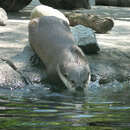pt-BR
nomes no trilho de navegação


Cape clawless otters are the second largest freshwater species of otter.Their name is derived from their characteristic partly webbed, clawless feet.
Quite therobust animal, cape clawless otters are predominantly brown with a white underbelly.Their elongated, agile bodies are well adapted for swimming.Its coat consists of densely packed underfur and long guard hairs that traps a pocket of insulated air underwater.
This mammal can be found inaquatic habitats– usually residing near perennial springs and rivers.Cape clawless otter prefer shallow water with thick reed beds full of their favourite crab and fish snacks.They will also feed on molluscs, birds, rodents and amphibians.They are no strangers to estuaries and the beach either – as long as there’s freshwater for drinking nearby.
Female otters may breed at any time of year and typically give birth to a litter of 1 -3 pups in a sheltered den.Females are devoted mothers and will teach the pups how to find and secure prey.Family groups are usually spotted during peak activity periods – usually early morning or late afternoon.
TheIUCNclassifies Cape clawless otters (Aonyx capensis) as a species of Least Concern.The species is widespread and most populations are thought to be stable.
For more information on MammalMAP, visit the MammalMAPvirtual museumorblog.